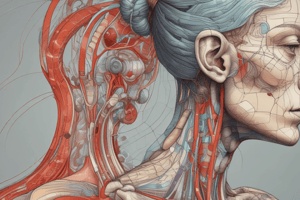Podcast
Questions and Answers
What type of receptor within the cochlea is primarily responsible for detecting sound?
What type of receptor within the cochlea is primarily responsible for detecting sound?
- Thermoreceptor
- Photoreceptor
- Mechanical receptor (correct)
- Osmoreceptor
Which type of hormone is known to be lipophilic?
Which type of hormone is known to be lipophilic?
- Luteinizing hormone
- Thyroid hormones (correct)
- Glucagon
- Insulin
What do chemokines primarily respond to in the body?
What do chemokines primarily respond to in the body?
- Chemical stimuli (correct)
- Temperature changes
- Mechanical stimuli
- Electrical impulses
Which part of the eye is responsible for changing shape to focus light on the retina?
Which part of the eye is responsible for changing shape to focus light on the retina?
What type of papillae are responsible for the sensation of taste?
What type of papillae are responsible for the sensation of taste?
Which hormone is primarily responsible for lowering blood calcium levels?
Which hormone is primarily responsible for lowering blood calcium levels?
Which of the following glands is classified as an endocrine organ?
Which of the following glands is classified as an endocrine organ?
What defines the difference between autocrine and paracrine signaling?
What defines the difference between autocrine and paracrine signaling?
Flashcards are hidden until you start studying
Study Notes
Receptors for Special Senses
- Mechanical Receptors: Located within the cochlea, responsible for hearing.
- Chemoreceptors: Respond to chemical stimuli; involved in taste and smell.
- Proprioceptors: Detect body position and movement; found in muscles and joints.
- Free Nerve Endings: Respond to pain, temperature, and some tactile stimuli.
Eye Features on Fundoscopy
- Optic Disc: Area where the optic nerve exits the eye; no photoreceptors, creating a blind spot.
- Receptors in Human Eyes:
- Cones: Responsible for color vision and detail in bright light.
- Rods: Responsible for vision in low light conditions.
Tongue Features
- Papillae Types: Filiform, fungiform, circumvallate, and foliate; each has specific roles in taste sensation.
Primary Cortices of Special Senses
- Cortex Location: Primary visual cortex, auditory cortex, gustatory cortex, and olfactory cortex each located in relevant brain regions.
Eye Light Focusing Mechanism
- Lens: Changes shape for accommodation, allowing for focus on near and distant objects.
- Components: Cornea, lens, and retina work together to refract light onto the retina.
Body Response to Stimuli
- Adaptation: The decreased sensitivity to continuous stimuli over time.
Taste and Gustatory Receptors
- Types of Taste: Sweet, sour, salty, bitter, and umami; each has corresponding gustatory receptors.
Secretion Mechanisms
- Autocrine: Cells respond to substances they secrete themselves.
- Paracrine: Cells respond to substances secreted by nearby cells.
Endocrine Organs
- Hypothalamus and Pituitary Connection: The hypothalamus regulates the pituitary gland, controlling many bodily functions.
- Endocrine Glands: Secrete hormones such as thyroid-stimulating hormone (TSH) from the thyroid.
Hormones by Endocrine Glands
- Thyroid Gland: Secretes hormones like thyroxine (T4) and calcitonin.
- Adrenal Glands: Secrete cortisol, adrenaline, and sex hormones.
Hormones and Solubility
- Hydrophilic Hormones: Water-soluble, cannot cross the cell membrane easily.
- Hydrophobic Hormones: Lipid-soluble, can pass through cell membranes.
Hormone Targets and Functions
- Parathyroid Hormone: Regulates blood calcium levels.
- Calcitonin: Lowers blood calcium levels.
- Insulin and Glucagon: Regulate blood sugar levels.
- Growth Hormone: Stimulates growth and cell reproduction.
- Luteinizing Hormone: Regulates ovulation and testosterone production.
Non-Endocrine Functions of Hypothalamus
- Regulates basic drives: Hunger, thirst, body temperature, and circadian rhythms.
Common Endocrine Pathologies
- Graves' Disease: An autoimmune condition leading to hyperthyroidism.
Blood Sugar and Calcium Regulation
- Hormones involved: Insulin lowers blood sugar, while glucagon raises it. Parathyroid hormone increases blood calcium, and calcitonin decreases it.
Eye Structures
- Refractive Structures: Lens focuses light, cornea provides initial refraction, and retina captures visual information.
Ear Structure Identification
- External Ear: Auricle and ear canal.
- Middle Ear: Ossicles (malleus, incus, stapes); amplifies sound.
- Internal Ear: Cochlea and vestibular system; involved in hearing and balance.
Special Sense Receptors
- Gustatory Cells: Involved in taste sensation.
- Olfactory Bulb and Nerve: Essential for the sense of smell.
Endocrine vs Exocrine Systems
- Endocrine Glands: Secrete hormones into the bloodstream for systemic effects.
- Exocrine Glands: Secrete substances through ducts to the outside of the body or onto epithelial surfaces.
Example of an Endocrine Gland
- Parathyroid Gland: Secretes parathyroid hormone, regulates calcium levels in the blood.
Studying That Suits You
Use AI to generate personalized quizzes and flashcards to suit your learning preferences.





